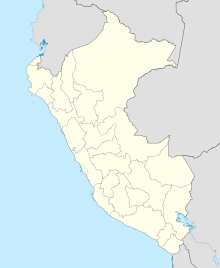Huaca Prieta
Huaca Prieta de Chicama is a late pre-ceramic Køkkenmødding ( Spanish Concheiro - clam heap ) on a peninsula above the sea in the Chicama Valley in Peru .
The hill is 15 m high and measures 122 × 46 m. The associated settlement was excavated in the 1940s. It goes to the year 2125 BC. BC and was continuously settled until the so-called initial period. It is a square with houses half sunk into the ground, the walls of which are covered with river pebbles .
The finds include the remains of cultivated plants from the pre-Inca period , such as the musk gourd ( Cucurbita moschata ) and the Capsicum baccatum , a plant from the nightshade family , which can be assigned to the peppers and chillies. In addition, wood, bones, baskets, shells, stone tools as well as twisted and knotted textiles, and in later layers also woven textiles, were found. Early artifacts can be recognized in the decorated pumpkin bottles and in the textile patterns. Conventionally designed fish, human, snake, animal and bird motifs as well as purely geometric shapes form the repertoire.
New excavations under and around the hill show very old traces of human activity, the oldest of which are around 15,000 years old.
literature
- Glyn Daniel (Ed.), Joachim Rehork (Ed.): Encyclopedia of Archeology. 1986, ISBN 3-88199-304-5 , p. 209
Individual evidence
- ↑ Tom D. Dillehay et al .: Simple technologies and diverse food strategies of the Late Pleistocene and Early Holocene at Huaca Prieta, Coastal Peru. In: Science Advances . American Association for the Advancement of Science , May 24, 2017, accessed June 15, 2017 .
Coordinates: 7 ° 55 ′ 26.4 ″ S , 79 ° 18 ′ 25.2 ″ W.
